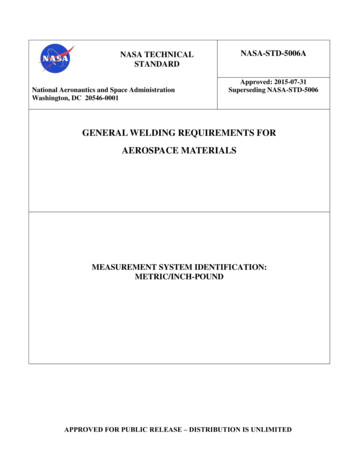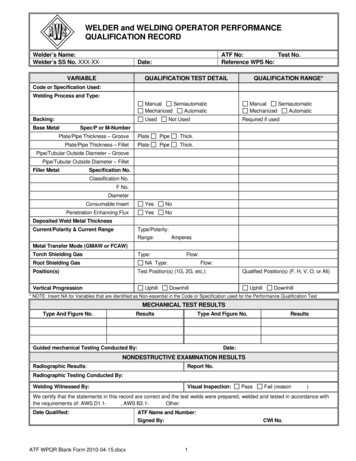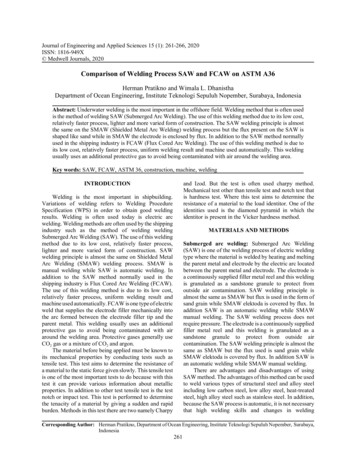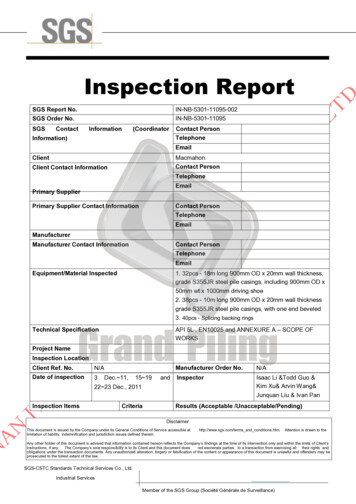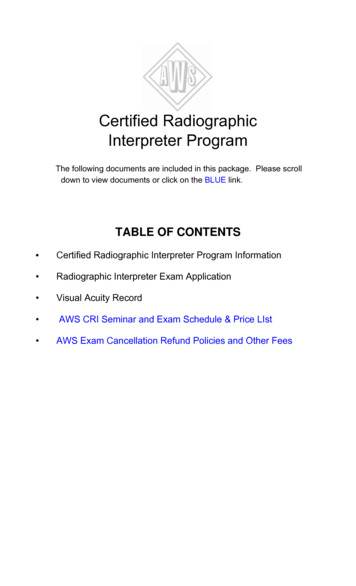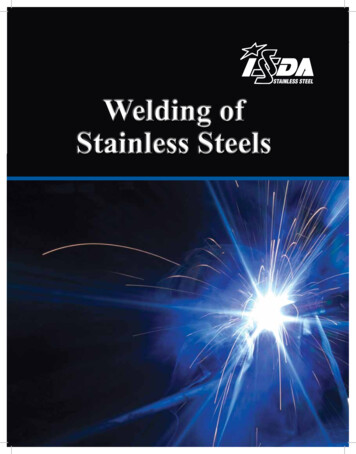
Transcription
IIW GuidelineINTERNATIONAL WELDING INSPECTIONPERSONNELMinimum Requirements for the Education,Examination and QualificationIAB-041r5-19/SV-00 Copyright European Federation for Welding, Joining and Cutting (EWF)
IAB – INTERNATIONAL AUTHORISATION BOARDIAB 041r5-19/SV-00MINIMUM REQUIREMENTS FOR THE EDUCATION, TRAINING,EXAMINATION, AND QUALIFICATION OF PERSONNELINTERNATIONAL WELDING INSPECTION PERSONNEL(IWIP)International Welding Inspector Level Comprehensive (IWI-C)International Welding Inspector Level Standard (IWI-S)International Welding Inspector Level Basic (IWI-B)This is a reduced version; it is not the full GuidelineFor more information regarding the Qualification System,the IAB/EWF Combined Secretariat or the National ANBshould be contacted(see in the IIW and/or EWF sites the ANB contacts)Guideline of the International Institute of WeldingINTERNATIONAL AUTHORISATION BOARDPrepared and issued by the IAB-International Authorisation Boardbased on the EWF Guideline EWF-450Under the authority of the IIW-International Institute of WeldingPublished by:EWF / IAB - IIW Management TeamAv. Prof. Dr. Cavaco Silva, 33Taguspark – Apartado 012P-2741-901 Porto SalvoPortugal Copyright EWFTel:Fax:E-mail: 351.21 4211351 351.21 ternational Welding Inspection PersonnelApproved: July 2019 - Copyright EWF2 of 20
IAB – INTERNATIONAL AUTHORISATION BOARDIAB 041r5-19/SV-00TABLE OF CONTENTSPreface . 41. Introduction and scope . 52. Definitions and acronyms . 53. The inspector’s role . 63.1. Reports . 64. Levels of Inspection Personnel . 74.1 Basic (IWI-B) . 74.2 Standard (IWI-S). 74.3 Comprehensive (IWI-C) . 85. Routes to Qualification . 86. Standard routes to Qualification . 86.1. Routes to qualification to IWI-C . 86.2. Routes to qualification to IWI-S . 96.3. Routes to qualification to IWI-B . 106.4. General rules for all standard routes . 107. Alternative Route to Qualification . 147.1. Qualification to IWI-C . 147.2. Qualification to IWI-S . 147.3. Qualification to IWI-B . 158. Recognition of NDT certification . 15Section 1 - Theoretical and practical education and training, modules WeldingTechnology and Welding Inspection: inspection syllabus and performance objectives. 16Theoretical education: Welding Technology Modules . 16Module 1. Welding processes and equipment . 16Module 2. Materials and their behaviour during welding . 16Module 3. Construction and design . 17Module 4. Fabrication, applications engineering. 17Theoretical education: Welding Inspection Modules . 18Module 1. Quality assurance /quality control in inspection . 18Module 2. Testing of welds and reporting . 18Module 3. Practical Tests on reporting . 18Theoretical education: Basic technology “Module 0“ . . 19Appendix II – Alternative Route – ANB Detailed Assessment . 20International Welding Inspection PersonnelApproved: July 2019 - Copyright EWF3 of 20
IAB – INTERNATIONAL AUTHORISATION BOARDIAB 041r5-19/SV-00PrefaceThis document is based upon the European Welding Inspection Personnel Guideline (formerDocument EWF-450) as developed by the European Federation for Welding, Joining andCutting (EWF), through an Agreement first signed in 19 July 1997 at the Annual Meeting of theInternational Institute of Welding in San Francisco, California, USA and which has beenrenewed and further developed since then.Any EWF ANB is permitted to issue EWF diplomas equivalent to the IIW ones that have beenissued by the same ANB.Copies of this document are available from the IIW IAB Secretariat or their designateddistributor.International Welding Inspection PersonnelApproved: July 2019 - Copyright EWF4 of 20
IAB – INTERNATIONAL AUTHORISATION BOARDIAB 041r5-19/SV-00MINIMUM REQUIREMENTS FOR THE EDUCATION, TRAINING ANDQUALIFICATION OF INTERNATIONAL WELDING INSPECTIONPERSONNEL (IWIP)1. Introduction and scopeThis Guideline covers education, training and qualification of Welding Inspection Personnel. Itdoes not cover Certification of these personnel.This Guideline is designed to provide the core education and training in welding and inspectiontechnology required by those responsible for performing inspection tasks at various levels. It ispossible that additional training and/or experience may be necessary beyond the core educationand training to meet the requirements of specific applications or job functions or localrequirements or legislation.Section 1 of this Guideline covers the minimum requirements for education and training, agreedupon by all national welding societies within the IIW, in terms of objectives, scope, learningoutcomes and teaching hours to be devoted to achieving them. These will be revisedperiodically by IIW IAB Group A to take into account any changes that may affect the “state ofthe art”. Students having successfully completed this course of education and training will beexpected to be capable of applying welding inspection technology as covered by this Guideline.Section 2 of this document covers rules for examination and qualification.2. Definitions and acronymsFor the scope of this Guideline, the following definitions apply:- Education and training: A process of instruction in relevant theory and practice that takesthe form of courses of an approved syllabus and periods of practical work under qualifiedsupervision (but shall not include the use of specimens used in the practical examination).All educational courses leading to the award of qualification covered by this Guidelineshallbe approved by the IIW Authorised Nominated Body (ANB).- Qualification: A demonstration in accordance with the IIW Guidelines and rules, conductedby the Authorised Nominated Body, involving an examination of the knowledge and skillrelated to specified criteria. Success in this examination leads to the issue of the related IIWdiploma gained. Such diplomas remain valid for the lifetime of the holder.- Relevant inspection experience: The period during which the candidate performedwelding inspection as his/her main activity under qualified supervision including personalapplication of inspection to materials, parts or structures.In the scope of this Guideline, the following acronyms are used for the inspection personnel:- IWIP:International Welding Inspection Personnel qualified according to this Guideline;- IWI-C: International Welding Inspector at the Comprehensive level;- IWI-S: International Welding Inspector at the Standard level;- IWI-B: International Welding Inspector at the Basic level;In the scope of this Guideline, the following acronyms are used for the education and trainingmodules:- WT-C: Welding Technology education and training, Comprehensive Level- WT-S: Welding Technology education and training, Standard Level- WT-B: Welding Technology education and training, Basic Level- WI-C:Welding Inspection education and training, Comprehensive Level- WI-S:Welding Inspection education and training, Standard LevelInternational Welding Inspection PersonnelApproved: July 2019 - Copyright EWF5 of 20
IAB – INTERNATIONAL AUTHORISATION BOARDIAB 041r5-19/SV-00-WI-B:Welding Inspection education and training, Basic LevelIn the scope of this Guideline, the following acronyms are used for the examinations:- WTE-C Welding Technology Exam, Comprehensive Level- WTE-S Welding Technology Exam, Standard Level- WTE-B Welding Technology Exam, Basic Level- WIE-C Welding Inspection Exam, Comprehensive Level- WIE-S Welding Inspection Exam, Standard Level- WIE-B Welding Inspection Exam, Basic Level- PE-CPractical Exam, Comprehensive Level- PE-SPractical Exam, Standard Level- PE-BPractical Exam, Basic Level- IWS 0 Examination as related to IWS 0 training, see Doc. IAB 252 in its last revision3. The Inspector’s roleThe inspector’s role begins well before welding starts, continues during the welding operation,involves action after welding is completed, and is finalised only when the results are properlyreported. As part of the quality system, inspection activities are defined in an inspection and testplan, which clearly describes what is required. The inspector is frequently responsible forproducing documents that ensure traceability of the components and related fabricating action.Prior to welding, the inspector must be assured that the materials are correct and that the shophas approved welding procedures and appropriately qualified welders. Written procedures andcompetent operators are important to the production of a quality welded product, but the actualexecution of the weld is also a critical point for the inspector. Once the inspector is satisfied thatall is in order for the welding to proceed, the task becomes one of witnessing and monitoring.There are two basic interests at this point: ensuring that the written procedures are beingfollowed; and checking for any physical signs of non-conformance of the final product.The inspector’s responsibilities are to verify base metals and welding consumables, observe thefit-up and preparation for the weld, and watch the welding operation itself. Once the welding iscompleted, a new series of inspection tasks begin, which start with executing an inspectionprogramme according to an approved procedure, maintaining the status of examination andtesting and selecting specific welds for further NDT or mechanical testing.Heat treatment (such as preheating, post-heating and post-weld heat treatment) can be acritical parameter in a welding operation and the inspector is often required to ensure that it hasbeen done properly. Heat treatment must be carried out following an approved writtenprocedure. The inspector must know enough about the technique, the equipment and thereports to have confidence in the results.3.1 ReportsWhen preparation, production and inspection are over, the inspector must collate theobservations, checklists, and results into a report that is structured to meet the needs of theclient, a jurisdiction, or a code. This report is the document of reference, which could allow thetracing of a production parameter that proves after years of service to be contributing to afailure. It allows the tracing of responsibility to a specific supplier or contractor.One or more interim reports might well be necessary to show progress during a long orcomplicated construction project. Reports must detail the inspection stages, parameters, andresults, including corrective actions if required. It is important to identify quality related problemsas early as possible. Interim reports and observations are extremely valuable as they provideengineering and production personnel with information they might not otherwise be aware of.International Welding Inspection PersonnelApproved: July 2019 - Copyright EWF6 of 20
IAB – INTERNATIONAL AUTHORISATION BOARDIAB 041r5-19/SV-00The inspector’s observations might highlight quality problems that could, perhaps, be remediedby design or production changes if found early enough. The inspector should remember toquantify observations where possible.Typical duties of a welding inspector amomgst others, are as follows:1) Interpretation of drawings and specifications;2) Verification of procedure (WPS) and welder or welding operator qualifications;3) Verification of the application of approved welding procedures;4) Selection of production test samples;5) Interpretation of test results;6) Preparation of reports and keeping of records;7) Preparation of inspection procedures; and8) Check the correct application of NDT methods.The authority to stop work or call for immediate remedial action to resolve a quality problem isparticularly important in defining the responsibility of the inspector.4. Levels of Inspection PersonnelThis Guideline sets out the education and training for three levels of welding inspectionpersonnel, as follows:4.1 BASIC (IWI-B): A candidate completing the “Basic” level of training under this programmeshall possess a general knowledge of welding and inspection application and theory. Thisknowledge base will enable the candidate to effectively perform the following tasks: Conduct direct unaided visual inspection to identify and evaluate welding imperfectionaccording to acceptance criteria; Verify, witness and understand all welding related activities in fabrication, including (but notlimited to) the following points: Verify the adequacy of information on NDT reports (VT, PT, MT, RT, UT) forconventional techniques; Verify data and adequacy of material certificates (base and filler materials); Verify identification and treacability of the materials during the fabrication process; Verify the compliance of raw materials and consumables against the applicablestandards, codes and specifications; Verify the implementation of the WPS in production for conventional applications (e.g.arc welding processes, steels - see Section 1 for detailed information); Verify the implementation of PWHT specifications in production; Witness welder approval tests including testing of the specimens or test coupons; Witness production test coupons; Read and understand an Inspection Testing Plan; Read and understand the construction drawings in relation to inspection activities; and Report any of the above actions to a qualified supervisor.4.2 STANDARD (IWI-S): A candidate completing the “Standard” level of training under thisprogramme shall possess an advanced knowledge of welding and inspection theory andapplication. This knowledge base will enable the candidate to perform the following tasks (inaddition to the IWI-B): Supervise the activities of the IWI-B; Develop and provide instructions to IWI-B; Develop, comment and review Quality Control Plans and Inspection and Testing Plansbased on product standards, codes, specifications, drawings and regulatory requirements; Witness procedure qualification tests including testing of the specimens;International Welding Inspection PersonnelApproved: July 2019 - Copyright EWF7 of 20
IAB – INTERNATIONAL AUTHORISATION BOARDIAB 041r5-19/SV-00 Verify the compliance of WQPRs and WPSs and welder qualifications and approvals againstthe applicable standards, codes and specifications for conventional applications (e.g. arcwelding processes, steels, aluminium alloys - see Section 1 for detailed information);Verify the compliance of PWHT specifications against the applicable standards, codes andspecifications;Verify the compliance of raw materials and consumables certificates against the applicablestandards, codes and specifications;Take decisions on acceptance of quality documents related to welding fabrication (e.g NDT,material testing, production testing, etc.);Take decisions based on quality documents (e.g NDT, material testing, production testing,etc.) according to the requirements defined for the construction;Verify radiographic films quality adequacy (no interpretation);Identify and verify the relevant NDT techniques for a welded construction; andReport on all the above actions.4.3 COMPREHENSIVE (IWI-C): A candidate completing the “Comprehensive” level of trainingunder this programme shall possess an intimate knowledge of welding and inspection theoryand application. This knowledge base will enable the candidate to perform the following tasks(in addition to the IWI-S and IWI-B): Manage the whole of the Welding Inspection activities; Supervise the activities of the IWI-S and IWI-B; Develop and provide instructions to IWI-S and IWI-B; Act as a technical expert for the Inspection function; Develop, comment and review Quality Control Plans and Inspection Testing Plans forapplications not covered by product standards, codes, specifications, drawings andregulatory requirements; and Manage inspection activities for non-conventional applications with reference to materials,processes, and advanced destructive testing and NDT techniques (see Section 1 fordetailed information).5. Routes to QualificationThree distinct routes to gaining the qualifications described in this document have been agreed:1. the Standard Route;2. the Alternative Route; and3. Distance Learning Programs (see IAB-195 in its last revision).It is also recognised that personnel certified for NDT at levels 1, 2 or 3 may be exempted frompart of the training, see paragraph 8.6. Standard Routes to QualificationThis Guideline provides different routes to qualification, based on different access conditionsand experience as follows.6.1 Routes to qualification to IWI-CRoute 1 This route is for those fulfilling the national standard access conditions for IWT orhigher, as defined in the directory of access conditions, doc. IAB 020 in its lastrevision.To gain the qualification, candidates should attend the education and training andpass the relevant exams as reported in Table 1 with the exception that candidatesmay decide on the basis of prior learning and/or experience and subject to an ATBassessment and authorisation to proceed directly to the Welding Technology ExamsInternational Welding Inspection PersonnelApproved: July 2019 - Copyright EWF8 of 20
IAB – INTERNATIONAL AUTHORISATION BOARDIAB 041r5-19/SV-00(WTE-S and WTE-C); only in this case, passing the WT exams is required beforeentering the Welding Inspection Education and Training Courses (WI-B, WI-S and WIC).At the discretion of the ANB, and only for students attending the full standard courseseducation and training, the Welding Technology Exams (WTE-S and WTE-C) can beperformed on the same day as the Welding Inspection Exams (WIE-S and WIE-C)and the Practical Exams (PE-S and PE-C). Route 1 is represented in figure 1.Route 2 This route is for those already holding an existing IIW qualification as InternationalWelding Technologist or higher who may proceed directly to the Welding InspectionModules at the relevant level. In this case, it is not required that applicants are subjectto WT examinations at the relevant level. Route 2 is represented in figure 1.Route 3 This Guideline considers a system for career development for those qualified IWI-Swho have gained two years of relevant inspection experience at IWI-S level toprogress to IWI-C (without complying with the access condition given in route 1) onlyattending WT-C and WI-C training and passing relevant Welding Technology,Inspection and Practical Exams (WTE-C, WIE-C and PE-C) via Route 3 as shown infigure 2.Candidates may decide, on the basis of prior learning and/or experience and subjectto an ATB assessment and authorisation, whether to take the Welding TechnologyModule (WT-C) first, or proceed directly to the Welding Technology Exam (WTE-C);only in this case, passing the exam is required before entering the Welding InspectionModule (WI-C).At the discretion of the ANB, and only for students attending the full standard courseseducation and training, the Welding Technology Exam (WTE-C) can be taken on thesame day of the Welding Inspection Exam (WIE-C) and the Practical exam (PE-C).Route 3 is represented in figure 2.6.2 Routes to qualification to IWI-SRoute 1 This route is for those fulfilling the national standard access conditions for IWS/EWSas defined in the directory of access conditions., doc. IAB 020 in its latest revision,Route 1 and 2, without any limitation in age or experience. To gain the IWI-Squalification, candidates should attend the education and training and pass therelevant exams as reported in table 1, with the exception that candidates may decideon the basis of prior learning and/or experience and subject to an ATB assessmentand authorisation to proceed directly to the Welding Technology Exam (WTE-S); onlyin this case, passing the WT exams (WTE-S) is required before entering the WeldingInspection Education and Training Courses (WI-B and WI-S).At the discretion of the ANB, and only for students attending the full standard courseseducation and training, the Welding Technology Exam (WTE-S) can be performed onthe same day as the Welding Inspection Exam (WIE-S) and the Practical Exam (PES). Route 1 is represented in figure 2.Route 2 This route is for those already holding an existing IIW qualification as InternationalWelding Specialist (or higher) who may proceed direct to the Welding InspectionModule at the relevant level. In this case it is not required that applicants are subjectto WT examination (WTE-S). Route 2 is represented in figure 1.Route 3 This Guideline considers a system for career development for those qualified to IWI-Bwho have gained two years of relevant inspection experience at IWI-B level, toprogress to IWI-S (without complying with the access condition given in route 1) byInternational Welding Inspection PersonnelApproved: July 2019 - Copyright EWF9 of 20
IAB – INTERNATIONAL AUTHORISATION BOARDIAB 041r5-19/SV-00only attending WT-S and WI-S education and training and passing relevant WeldingTechnology, Inspection and Practical Exams (WTE-S, WIE-S and PE-S). Thoseentering IWI-S via route 3 without satisfying the access condition for Route 1, have toproceed to IWS 0 training and examination, see doc. IAB 252 in its last revision,before entering the Welding Technology education and training. Route 3 is shown infigure 2.In addition, candidates may decide on the basis of prior learning and/or experienceand subject to an ATB assessment and authorisation, to proceed directly to theWelding Technology Exam (WTE-S); only in this case, passing the exam is requiredbefore entering the Welding Inspection Module and Practical Examinations (WIE-Sand PE-S).At the discretion of the ANB, and only for students attending the full standard courseseducation and training, the Welding Technology Exam (WTS-S) can be performed onthe same day of the Welding Inspection Exam (WIE WIS-S) and the Practical Exam(PE-C). Route 3 is represented in figure 2.6.3 Routes to qualification to IWI-BRoute 1 This route is applicable to persons having educational backgrounds in science orengineering, to professional workers and to those having at least two years ofprofessional welding related experience. To gain the IWI-B qualification, candidatesshould attend the education and training and pass the relevant exams as reported intable 1, with the exception that candidates may decide on the basis of prior learningand/or experience and subject to an ATB assessment and authorisation to proceeddirectly to the Welding Technology Exam (WTE-B); only in this case, passing the WTExams is required before entering the Welding Inspection Education and TrainingCourse (WI-B).At the discretion of the ANB, and only for students attending the full standard courseseducation and training, the Welding Technology Exam (WTE-B) can be performed onthe same day as the Welding Inspection Exam (WIE-B) and the Practical Exam (PEB). Route 1 is represented in figure 1.Route 2 This route is for those already holding an existing IIW qualification as InternationalWelding Practitioner or higher who may proceed direct to the Welding InspectionModule at the relevant level. In this case it is not required that applicants are subjectto WT examination at the relevant level. Route 2 is represented in figure 1.6.4 General rules for all standard routesFor all Routes, if the candidate fails the Welding Technology Examination twice at theappropriate level, having exercised an option to proceed directly to that examination, he/shemust take the omitted training module before resitting the failed examination.Rules for IWS 0 are reported in doc. IAB 252, in its last revision.The rules for the conduct of the examinations by the IIW Authorised Nominated Body (ANB) areprescribed in Section 2 of this Guideline.International Welding Inspection PersonnelApproved: July 2019 - Copyright EWF10 of 20
IAB – INTERNATIONAL AUTHORISATION BOARDIAB 041r5-19/SV-00Education and trainingLevelIWI-CIWI-SWeldingtechnology (*)WT-B (47h) WT-S (30h) WT-C (26h)WeldinginspectionWI-B (55h) WI-S (41h) WI-C (32h)Total: 103hWT-B (47h) WT-S (30h)Total: 128hWI-B (55h) WI-S (41h)Total: 77hWT-B (47h)Total: 96hWI-B (55h)Examinations (route 1)WeldingtechnologyWeldinginspectionPracticalWTE-C WTE-S WTE-BWIE-C WIE-S WIE-BPE-C PE-SWTE-S WTE-BWIE-S WIE-BPE-SIWI-BWTE-BWIE-BPE-BTotal: 47hTotal: 55h(*) Subject to an ATB assessment, the Welding Technology exams can be skipped at theappropriate level before entering Welding Inspection education and training.Table 1 – Standard routes for qualification for IWIP, Route 1International Welding Inspection PersonnelApproved: July 2019 - Copyright EWF11 of 20
IAB – INTERNATIONAL AUTHORISATION BOARDIAB 041r5-19/SV-00Access conditionsWelding Technologyeducation and trainingWelding Inspectioneducation and trainingRouteWelding Inpsection andPractical ExamsWelding TechnologyExams1Access conditions for IWT or higherWT-B WT-S WT-C(103h)WTE-B WTE-S WTE-CWI-B WI-S WI-C(128h)WIE-B WIE-S WIE-CWTE-B WTE-SWI-B WI-S(96h)WIE-B WIE-SPE-SWTE-BWI-B(55h)WIE-BPE-BPE-S PE-CIWI-CATBCheck2 Holders of IWT or IWE diploma1Access conditions for IWS without anylimitation in age or experienceWT-B WT-S(77h)IWI-SATBCheck21Holders of IWS diplomaProfessional workers or persons havingeducational backgrounds in science orengineering or at least two years ofprofessional welding related experienceWT-B(47h)IWI-BATBCheck2 Holders of IWP diplomaATBCheck- ATB AssessmentFigure 1. Standard Routes 1 and 2(The diagram has the only scope to show routes to qualification, see text for requirements)International Welding Inspection PersonnelApproved: July 2019 - Copyright EWF12 of 20
IAB – INTERNATIONAL AUTHORISATION BOARDIAB 041r5-19/SV-00Welding Technologyeducation and trainingWelding Inspectioneducation and trainingWelding TechnologyExamsWT-C(26h)WTE-CWelding Inspection andPractical ExamWI-C(32h)ATBCheckWIE-CPE-CIWI-CHolders of IWI-S diploma with two yearsexperience in Welding Inspection at theStandard levelWT-S(30h)WTE-SWI-S(41h)ATBCheckIWS 0(Duration*)IWS-0** ENTRY TEST(IWS 0 Examination)WIE-SPE-S3IWI-SHolders of IWI-B diploma with two yearsexperience in Welding Inspection at theBasic level3ATBCheckThose able to prove that theyachieved the knowledge prescribedin IWS Part 0 (option 2)*Those satisfying access conditions for IWI-S, route 1ATBCheck- ATB Assessments* See doc. IAB 252r1, last revisionFigure 2. Standard Route 3(The diagram has the only scope to show route 3 to qualification, see text for requirements)International Welding Inspection PersonnelApproved: July 2019 - Copyright EWF13 of 20
IAB – INTERNATIONAL AUTHORISATION BOARDIAB 041r5-19/SV-007. Alternative routes to qualificationTo gain qualification according to the Alternative Route, applicants shall submit an applicationform to the ANB together with the documents indicated in paragraphs 5.1 to 5.3 for a paperassessment.The ANB shall conduct a paper assessment to ensure that the applicant meets the AccessConditions for the Alternative Route (see the list of access conditions, doc IAB 020 in its lastrevision) and evaluate the applicant’s practice and related job function in welding inspection.The result of this assessment shall determine if the applicant is suitable for further detailedassessment (see Appendix II).Standa
International Welding Inspector Level Comprehensive (IWI-C) International Welding Inspector Level Standard (IWI-S) International Welding Inspector Level Basic (IWI-B) This is a reduced version; it is not the full Guideline For more information regarding the Qualification System, the IAB/EWF Combined Secretariat or the National ANB



